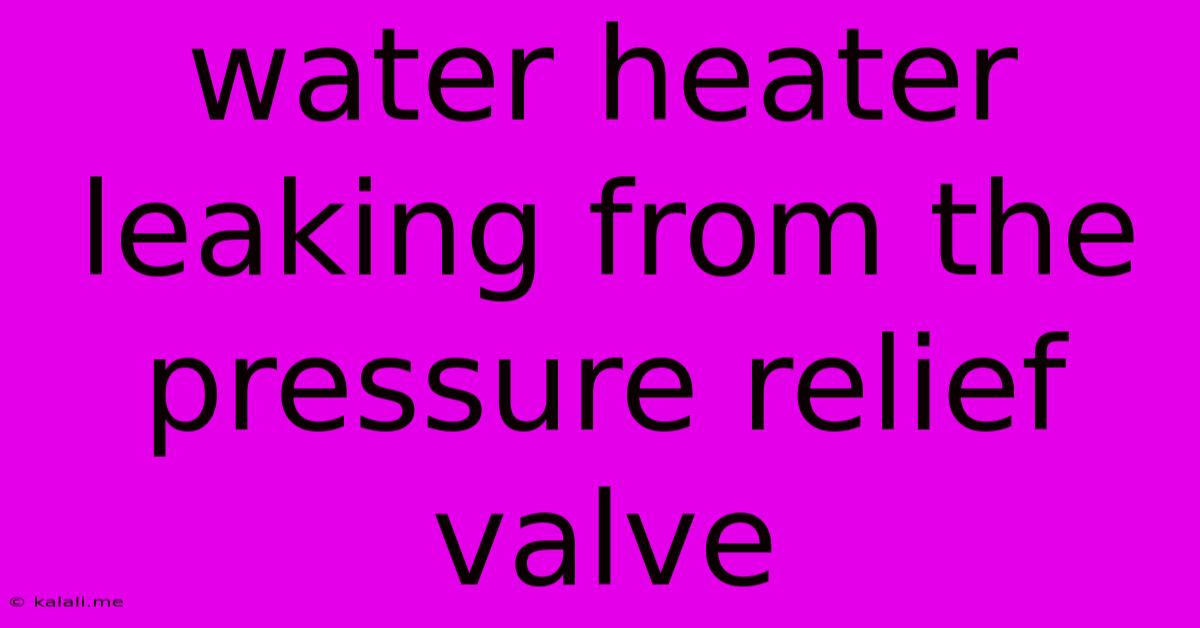Water Heater Leaking From The Pressure Relief Valve
Kalali
May 21, 2025 · 4 min read

Table of Contents
Water Heater Leaking From the Pressure Relief Valve: Causes and Solutions
A leaky water heater pressure relief valve can be a frustrating and potentially damaging problem. This article will guide you through understanding why your water heater is leaking from this valve, the potential causes, and how to troubleshoot and fix the issue. Ignoring a leaking pressure relief valve can lead to water damage, increased utility bills, and even serious safety hazards. Let's dive into the details.
Understanding the Pressure Relief Valve
The pressure relief valve (PRV) is a crucial safety device on your water heater. Its job is to release excess pressure and prevent the tank from exploding. This pressure can build up due to several factors, including overheating, sediment buildup, and a faulty temperature and pressure relief (T&P) valve. When the pressure exceeds a certain limit, the valve opens, releasing hot water to alleviate the pressure. A leak indicates the valve is either malfunctioning or responding to a problem within the water heater system itself.
Common Causes of a Leaking Pressure Relief Valve
Several factors can contribute to a water heater leaking from its pressure relief valve. Here are some of the most common:
-
Excess Pressure: This is the primary reason. A buildup of pressure within the tank, exceeding the valve's threshold, will force it to open and release water. This can result from a faulty thermostat, a blocked dip tube, or mineral buildup within the tank.
-
Faulty Pressure Relief Valve: The valve itself might be malfunctioning. Over time, the valve's internal components can wear down, causing it to leak even at normal operating pressure. This could be due to corrosion, mineral deposits, or simply age.
-
Temperature and Pressure Relief Valve (T&P) Issues: Although often referred to interchangeably, the PRV and T&P valve are essentially the same safety mechanism. Issues with the internal components of the T&P valve can cause it to leak.
-
Expansion Tank Problems: If your system incorporates an expansion tank, a problem with it, such as a faulty bladder or insufficient air pressure, can force excess pressure into the water heater tank, triggering the PRV.
-
Sediment Buildup: Mineral deposits and sediment accumulating at the bottom of the tank can restrict water flow, leading to increased pressure.
Troubleshooting Your Leaky Water Heater
Before attempting any repairs, remember safety first! Turn off the power or gas supply to the water heater. Allow the tank to cool completely before proceeding.
Here's a step-by-step troubleshooting guide:
-
Check for Excess Pressure: Carefully examine the water heater for any signs of excessive pressure. If there’s no obvious leak besides the PRV, the pressure might be the root cause.
-
Inspect the Pressure Relief Valve: Carefully inspect the valve itself for any signs of damage, corrosion, or mineral buildup. A simple visual check might reveal the problem.
-
Test the Valve: You can manually test the valve by lightly lifting the lever. A small amount of water might drip out, which is normal, but a continuous stream indicates a problem.
-
Check the Water Heater Thermostat: Ensure the thermostat is set correctly and functioning properly. A faulty thermostat can cause overheating, leading to excess pressure.
-
Examine the Dip Tube: A clogged dip tube can restrict cold water inflow, potentially leading to overheating.
-
Inspect the Expansion Tank (if applicable): Check the expansion tank's air pressure. Low air pressure can force extra pressure to the water heater.
Repairing or Replacing the Pressure Relief Valve
If your troubleshooting points to a faulty PRV, replacing it is often the best solution. This is typically a relatively simple DIY repair. However, if you're uncomfortable working with plumbing or electricity, it's always best to call a qualified plumber.
Remember to always follow manufacturer instructions when replacing the valve. Incorrect installation can lead to safety hazards.
Prevention is Key
Regular maintenance can help prevent future leaks. This includes:
- Annual Flushing: Flushing the tank to remove sediment buildup.
- Inspecting the Valve: Regularly checking the valve for any signs of wear and tear.
- Maintaining Proper Water Pressure: Ensuring your home's water pressure is within the recommended range.
A leaking pressure relief valve is a serious issue that requires prompt attention. By understanding the causes and following the troubleshooting steps outlined above, you can identify the problem and take the necessary steps to ensure the safety and longevity of your water heater. Remember, if you're unsure about any aspect of the repair process, always consult a qualified professional.
Latest Posts
Latest Posts
-
Mw Remastered Out Of Memory Error
May 21, 2025
-
Whats The Difference Between A Chicken And Hen
May 21, 2025
-
If I Was You Or If I Were You
May 21, 2025
-
How To Change Google Account Profile Picture
May 21, 2025
-
Can You Bring An Xbox On A Plane
May 21, 2025
Related Post
Thank you for visiting our website which covers about Water Heater Leaking From The Pressure Relief Valve . We hope the information provided has been useful to you. Feel free to contact us if you have any questions or need further assistance. See you next time and don't miss to bookmark.